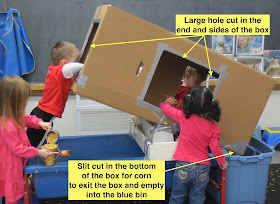I propped the box on an incline using a planter tray in a wooden tray that spanned the width of the table. I taped the box down at the points where the box made contact with the trays and the lip of the table. In the picture, it might look like the child leaning into the box at the top just might bring the whole thing down, but it was taped down well enough to pass the child-pulling-down-on-it test. You can find the original post here.
Throughout my career, I changed the apparatus in the sensory table religiously every week. Sometimes that meant I modified an existing apparatus. The wardrobe box on an incline was such a case. I simply added a clear plastic tube that ran the length of the box on the bottom.
What I expected children to do was to pour the corn down the clear plastic tube. As predicted, they did and as they did, they closely watched how the corn slid down the tube.
If someone was pouring up top, then another child at the bottom would catch the corn coming out of the tube. Again, as predicted, a child would inevitably catch the corn coming out of the bottom of the tube. However, since the children could not see each other, there were challenges in synchronizing the pouring and catching of the corn.
Catching the corn from Thomas Bedard on Vimeo.
This was actually a nice bit of cooperation, communication and persistence. The child at the bottom wanted to fill his cup completely. He only caught a few kernels from the first corn that was dropped down the tube. The second time, the child up top poured more corn down the tube, but the child on the bottom was out of position to catch all the corn he wanted. The child on the bottom asked the child on top for a big scoop. When the child up top poured this time, the child at the bottom was ready. To his delight, he was able to fill his cup.
The children quickly figured out that the metal cup fit nicely over the clear plastic tube which allowed them to plug it. See the corollary to Axiom #6 on the right hand column of this blog: whenever possible, the children will completely block the flow of a medium.
Once they figured out that they could block the tube, a whole new set of operations emerged. One of them was to fill the tube with the corn and whatever else would fit down the tube. Early in the week, someone forced something into the tube that eventually got stuck in the tube. I found a couple of sticks and offered them to the children so they could push the the object out the bottom of the tube. I decided to leave the sticks in the area for further play. As the children filled the tube, they started to use the sticks to jam the corn in the tube.
Jamming corn in the tube from Thomas Bedard on Vimeo.
Why did the children decide to try to push the corn further down the tube? How did the children know they could use the sticks to that end? They seemed to have had a plan and were already accomplished "jammers." Did you see how close the boy's stick came to the girl's head when he was jamming? Was the productive use of the sticks worth the risk? What do you think?
When the plug was pulled and the corn emptied out of the tube, one of the children put a stick down the tube. That created a problem: how to get the stick out. The child tried to pull it out at the bottom but it kept hitting the bin so he could not get it out.
Since he could not get it out through the bottom, he started pushing it back up the tube. When he did that, he asked the girl if she could reach it. The first time he asked, he did not get a response. He re-positioned his body in an attempt to talk around the box instead of through it. The second time he asked, she heard and took a look down the tube to see what he wanted her to reach.
I want you to reach it from Thomas Bedard on Vimeo.
The girl could not reach it, so the boy found a long-handled paint brush to push the stick further up the tube. What a nice bit of tool making to extend his reach! When he did that, the stick actually touched the girl's fingers. She still insisted that she could not quite reach it.
I can't quite reach it from Thomas Bedard on Vimeo.
Eventually, she grabbed it and pulled it out of the tube. After looking at the video, I think she could have reached the stick sooner, but she was teasing her companion just a little bit. Just look at her smile at the end of the video.
I can't even begin to deconstruct the images in this post because the play and exploration is so complex. The images are snapshots in time; I can see what is happening in those images, but my understanding of what children are thinking is only partial. I essentially miss all that happens before and after and in between the captured images, which undoubtedly is important to understanding the action.
I am not saying we should not try to deconstruct the images because how else will we know on some level the children and their thoughts. However, at some point, I just want to relish the gestalt of the ebb and flow of the children actions around the box with the tube, the corn and the sticks. For me, the whole breadth of the action is greater than the sum of its parts.





No comments:
Post a Comment